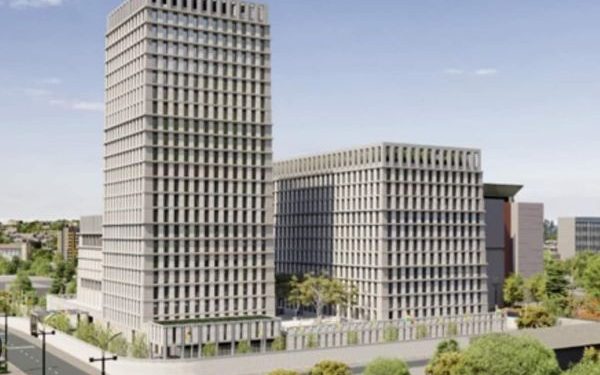The Bank of Ghana (BoG) grows assets by a massive expansion of its balance sheet in 2024, increasing total by GH¢74.6 billion (GH¢74,646,937,000) in one financial year.
The total BoG assets grow and rose sharply from GH¢140.41 billion (GH¢140,413,541,000) in 2023 to GH¢215.06 billion (GH¢215,060,478,000).
This BoG grows assets by 53% increase marks a significant deepening of the central bank’s financial activities even as profitability continues to weaken.
The expansion reflects growing foreign reserves, rising gold holdings, increased securities, and a broader array of financial assets and investments on the Bank’s books.
Gold reserves more than double
A major driver of the asset surge was the sharp rise in gold holdings.
The value of BoG’s gold climbed from GH¢14.03 billion (GH¢14,028,296,000) in 2023 to GH¢33.56 billion (GH¢33,561,495,000) in 2024 — more than doubling in a year. Collateralised gold holdings also increased to GH¢5.98 billion (GH¢5,979,951,000), up from GH¢3.80 billion (GH¢3,796,842,000) in 2023.
These increases are in line with Ghana’s broader strategy to enhance foreign exchange reserves through gold accumulation, especially under initiatives like the Gold-for-Reserves and Gold-for-Oil programmes.
Liquidity position strengthens
The Bank’s cash and balances with correspondent banks more than doubled, reaching GH¢33.87 billion (GH¢33,866,173,000) in 2024 compared to GH¢13.33 billion (GH¢13,333,842,000) in the previous year.
This improved liquidity position may provide the BoG with greater flexibility to intervene in currency markets or support domestic financial institutions in times of stress.
Rising foreign and domestic assets
The BoG’s holdings with the International Monetary Fund (IMF) also grew from GH¢11.81 billion (GH¢11,813,752,000) in 2023 to GH¢14.18 billion (GH¢14,183,104,000) in 2024.
The portion lent to the government rose to GH¢29.02 billion (GH¢29,023,391,000), from GH¢24.13 billion (GH¢24,131,883,000) the year before — a notable sign of the government’s continued reliance on multilateral support to finance its operations.
Securities held by the BoG climbed to GH¢71.59 billion (GH¢71,588,785,000) in 2024, up from GH¢59.35 billion (GH¢59,354,427,000) in 2023, reflecting the Bank’s expanded role in managing public debt and absorbing financial instruments within the domestic market.
Loans and advances by the BoG also rose, hitting GH¢2.98 billion (GH¢2,975,285,000) in 2024, up from GH¢1.75 billion (GH¢1,751,484,000) the year before.
Growth in non-financial assets
Other key components of the BoG’s asset structure also saw significant growth.
Other assets more than doubled, from GH¢6.06 billion (GH¢6,056,961,000) in 2023 to GH¢15.64 billion (GH¢15,636,917,000) in 2024.
Investments rose modestly from GH¢2.24 billion (GH¢2,240,338,000) to GH¢2.80 billion (GH¢2,797,510,000), while property, plant, and equipment increased from GH¢3.42 billion (GH¢3,420,179,000) to GH¢4.82 billion (GH¢4,822,463,000).
Investment property was GH¢193.65 million (GH¢193,650,000) in 2024, up slightly from GH¢185.96 million (GH¢185,962,000) in 2023.
Intangible assets also more than doubled, reaching GH¢431.75 million (GH¢431,754,000), from GH¢207.52 million (GH¢207,517,000) the previous year.
Interestingly, derivative financial assets, which stood at GH¢92.06 million (GH¢92,058,000) in 2023, were completely absent from the 2024 balance sheet.
Bigger, riskier, and more exposed
While the balance sheet expansion reflects Ghana’s effort to shore up foreign reserves, stabilise the economy, and support government financing, it also raises key concerns.
First, the rapid BoG’s growth of assets, particularly its exposure to government securities and on-lent IMF funds, may heighten its vulnerability to sovereign risk.
This is especially relevant as the country continues navigating external debt restructuring and fiscal pressures.
Second, the expansion is not backed by profitability.
The BoG recently reported a GH¢9.49 billion loss for 2024, raising concerns about the sustainability of this growth and whether the institution can absorb further shocks without eroding its capital further.
Third, the increase in physical assets, investments, and other intangible holdings points to a more complex institutional profile that may require greater oversight, transparency, and risk management.
The BoG grows assets base has grown significantly, reflecting a bold policy stance aimed at securing economic resilience in the face of global and domestic uncertainties.
However, the growth in assets comes at a time of persistent operating losses, growing exposure to sovereign obligations, and increasing operational complexity.
As the BoG balances its stabilisation role with financial sustainability, the stakes for Ghana’s broader economic recovery remain high.
The BoG grows assets by 53% to GH¢215bn in 2024 means a lot to the Ghanaian economy.












